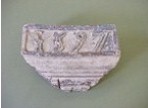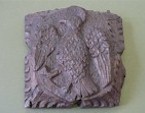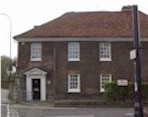 |
 |
 |
 |
 |

In this section: Introduction > Manor Gatehouse
> 17th & 18th century mansions
INTRODUCTION
BUILDINGS IN DARTFORD 1500-1800
|
|
|
|
| |
Beam end |
 |
| Picture credit: Dartford Museum |
It is a pity that many of the buildings constructed in Dartford
1500-1800 have not survived. Some were demolished in the nineteenth and twentieth
centuries to make way for new developments, others were destroyed by fire or enemy bombs.
Our knowledge of some of the larger Tudor, Stuart and Georgian town houses comes only from
documents, property inventories, or old prints. Very little information has survived about
the houses of ordinary townsfolk. What is clear, is that many of the town’s buildings
still standing in 1800 were constructed in medieval or Tudor times. These timber-framed
properties were sufficiently well-built to stand the test of time. Property formerly owned
by the Church passed into lay hands. For example, Church houses in Overy Street were
converted for use as ordinary residential dwellings.
|
|
| |
Carved eagle head |
 |
| Picture credit: Dartford Museum |
The following buildings were constructed or converted in Dartford
during this period. Henry VIII’s Dartford Manor House (1541-1544); Horsman’s
Place, Lowfield Street (1551); the House of Correction, Dartford High Street (1559); The
Market House, Dartford High Street (1576); the Manor House of Charles, Dartford High
Street (sixteenth century); Lowfield Almshouses (sixteenth century); Twisleton’s
Almshouses, West Hill (1704); Dartford Bridewell, Lowfield Street (1720); Dartford
Workhouse, West Hill (1728-9); the Wesleyan Chapel, Hythe Street (1794) and Phoenix Mills
(1797).
|
|
| |
Bridge house |
 |
|
A few seventeenth and eighteenth century buildings can still be
found around the town centre. These include Bridge House (opposite Holy Trinity church),
and the ‘Malt Shovel’ pub, Darenth Road (1673). Some of the modern-looking
facades in Dartford High Street conceal medieval and Tudor timber-framed buildings. |
|
| |
Twisleton's Almshouses |
 |
|
After the Great Fire of London in 1666, various laws were passed
to regulate house construction. The aim of this legislation was to make houses and public
buildings as safe as possible. Brick and stone became the standard building materials used
in London and provincial market towns like Dartford. However, unscrupulous builders often
skimped on the number of bricks used in the construction of town houses and public
buildings, resulting in dangerous structures. Dartford Bridewell (1720) was constructed of
brick.
Next topic: Manor Gatehouse
|
 |
|
| |
|
 |
 |
| |
|
